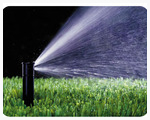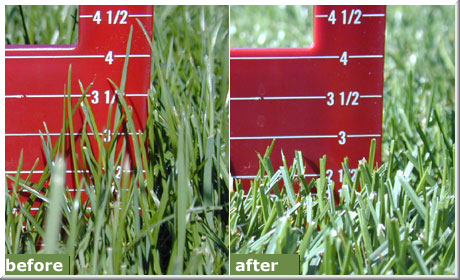Watering Your Lawn
 Even though temperatures might be cooler than in summer, your lawn still needs water. Since lawn grasses continue to grow throughout the fall, watering is still important to sustain growth. Go ahead and water as needed, usually about an inch to an inch and a half per week, until the ground is cold and beginning to freeze. If you have an automatic irrigation system, avoid damage by having it blown out with compressed air before water freezes in the pipes and sprinkler heads.
Even though temperatures might be cooler than in summer, your lawn still needs water. Since lawn grasses continue to grow throughout the fall, watering is still important to sustain growth. Go ahead and water as needed, usually about an inch to an inch and a half per week, until the ground is cold and beginning to freeze. If you have an automatic irrigation system, avoid damage by having it blown out with compressed air before water freezes in the pipes and sprinkler heads.
A quick note on winter watering: Even dormant grass needs some moisture. In addition, winter watering of exposed areas of the lawn, particularly south and west facing areas, can cut down on winter mite damage. For yards with a history of mite damage, Mountain High does offer winter mite sprays, but even with chemical control, winter watering may be needed in dry areas.
Broadleaf Weed Control
Fall is a good time to control perennial broadleaf weeds such as dandelions, plantain, clover, and mallow. If your weeds are few and scattered—or confined to a few small areas—spot-treating them with herbicide is usually sufficient. Weed-control products sold in ready-to-use spray containers make spot treatment easy. Make sure to complete treatments when temperatures are still warm enough to be effective. Herbicides are only effective when the weeds are still actively growing, so the application needs to be done before winter cold sets in.
Fertilizing Your Lawn
Applying a final dose of fertilizer in September or October will set your lawn up for a quicker recovery. (Not necessary if you are on our Extended Release lawn program.) This winterizing fertilizer provides your grass with nutrients that will be absorbed and stored until needed for spring growth. Lawns that have received late-season fertilizing are often the first to begin growing in the spring.
Seeding and Sodding Your Lawn
Fall is normally the best time of year to put down seed or sod to repair lawns damaged by summer heat. Seeding should be completed before the end of September. Cool temperatures usually make fall seeding or sodding successful. However, this year, the extreme drought conditions will make seeding less effective since soil moisture content is low, and watering restrictions make getting enough water every day to keep soil moist both tough to do and expensive. Spring seeding may be a better option for many people.
An application of Revive from Mountain High can help spur some growth and recovery, and is a good option for yards with some summer drought damage.
Raking Leaves
Lawn raking in the fall removes excess organic debris, and can help maintain water quality. In winter, freezing and thawing can cause leaves, dead grass plants, and other organic debris to mat and cause snow mold under snow packed areas
Recycling Leaves
There are several environmentally friendly options when it  comes to disposing of fallen leaves. The preferred way is to compost them, because composting keeps leaves out of streets and storm sewers. You can also use fallen leaves, whole or chipped by a power mower, as winter mulch around rose bushes and landscape plants. Whatever method you use, remember that the cleaner a lawn is going into the winter the quicker the recovery will be when spring hits.
comes to disposing of fallen leaves. The preferred way is to compost them, because composting keeps leaves out of streets and storm sewers. You can also use fallen leaves, whole or chipped by a power mower, as winter mulch around rose bushes and landscape plants. Whatever method you use, remember that the cleaner a lawn is going into the winter the quicker the recovery will be when spring hits.
Mowing Your Lawn
 It’s important to keep your grass 2 to 2-1/2 inches tall throughout the fall. If your grass gets much longer (more than 3 inches) it will mat, leading to winter lawn disease problems such as snow mold. If you cut it shorter than 2 inches, you’ll severely limit its ability to make and store food for growth in the spring.
It’s important to keep your grass 2 to 2-1/2 inches tall throughout the fall. If your grass gets much longer (more than 3 inches) it will mat, leading to winter lawn disease problems such as snow mold. If you cut it shorter than 2 inches, you’ll severely limit its ability to make and store food for growth in the spring.
